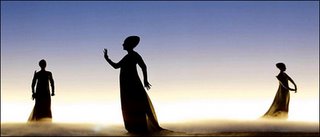
Audiences Love a Minimalist 'Ring' Cycle; Critics Aren't Sure
PARIS, Nov. 1 - Productions of Wagner's "Ring des Nibelungen" have one thing in common: rarely do director, designer, conductor, orchestra and singers all emerge unscathed. The reason is simple. Audiences and critics often embark on this four-opera cycle with firm views on how its immense musical and mythical universe should look and sound.
Still, with Robert Wilson's "Ring," first presented at the Zurich Opera from 2000 to 2002 and now at the Théâtre du Châtelet here, Parisians at least know what to expect. Over the last three decades, in both opera and theater, they have grown used to Mr. Wilson's signature stagecraft of dramatic lighting, costumes in solid colors, minimalist décor and stylized acting. (Forget about naked Rhinemaidens, burning castles and helmeted Valkyries.) The question was how this abstract approach would serve Wagner's monumental work.
So far, opinions are divided or, rather, fragmented. Audiences have responded with great enthusiasm to "Das Rheingold" and "Die Walküre," the first two works in the "Ring." In contrast, French critics have dissected the productions to identify what they liked and disliked, with their sharpest criticism aimed at Christoph Eschenbach, who is conducting the Orchestre de Paris.
But the final verdict must await the new year. The last chapters, "Siegfried" and "Götterdämmerung," will be presented in January and February, followed by two complete cycles from March 30 to April 15. And in April, Plácido Domingo will replace Peter Seiffert as Siegmund in "Die Walküre."
Of course, the basic "look" of Mr. Wilson's "Ring," with its strong echoes of Japanese Noh theater, is unlikely to change. Indeed, as Mr. Wilson has done before in, say, "Parsifal" and Debussy's "Pelléas et Mélisande," rejecting what he calls "decorative" illustration of the narrative, he uses austerity and self-control to create a space in which music and libretto can breathe freely.
Here his lighting is the star: innumerable shades of color reflect the changing mood of the plot, while spotlights isolate the face or hands of silhouetted figures. The gods, including the one-eyed Wotan, seem no less otherworldly. Wearing Frida Parmeggiani's single-color, neo-Cubist costumes, they move with almost robotic gestures. But even the "human" lovers, Siegmund and Sieglinde, avoid any physical contact.
"Above all, I try not to impose my interpretation on the work in order to leave room for interrogation," Mr. Wilson explained in an interview in the Châtelet's program book. "Theater is often too dictatorial. A writer, director or designer has an idea and insists on it. This leaves no room for exchanges, for other ideas."
Defending the sobriety of his approach to the "Ring," he added: "In my view, with a work that is already full of overwhelming emotions, a production that is equally moving and emotional makes no sense."
What this means in practice is that it is left largely to the orchestra and voices to convey the drama. In "Das Rheingold," for instance, the giants Fasolt and Fafner, who want to ransom Freia for gold, tower over the set, but they are menacing only in the words they sing. Somewhat more sinister is Alberich, who takes the gold of the Rhinemaidens in exchange for renouncing love.
In both "Das Rheingold" and "Die Walküre," the cast pleased the audience more than it did the critics. Jukka Rasilainen's Wotan, Mr. Seiffert's Siegmund, Petra-Maria Schnitzer's Sieglinde and Linda Watson's Brünnhilde were all warmly applauded, but French critics felt that the singers were somewhat miscast. In contrast, there was unanimous praise for both the timbre and stage presence of Mihoko Fujimura's Fricka, the guardian of marriage.
Mr. Eschenbach, never much loved by French music critics since taking over the Orchestre de Paris in 2000, fares less well. Writing in Le Figaro, Christian Merlin said he had "nothing of an opera conductor," adding that he failed to control the "thunder" of the orchestra's brass. In Le Monde, Marie-Aude Roux wrote that his conducting was "heavy, despite some often enigmatic and disturbing tempo changes."
Yet every "Ring" audience is also crowded with Wagner experts, and they, at least, went overboard with cheers for Mr. Seiffert and Ms. Schnitzer's long love duet, which dominates Act I of "Die Walküre." Even Mr. Eschenbach was heartily applauded - if only to drown out some boos - at the final curtain of this opera.
Nonetheless, the program interviews illustrate how the director and conductor of the same production can have different views of Wagner's 15-hour masterpiece.
"The Ring is a family saga," said Mr. Wilson, a Texas-born American. "It is a children's story. It has a god, dwarves, giants and bad guys. I would not want to make my 'Ring' too heavy, too intellectual. All true theater people I know have a little child hidden inside them."
But for Mr. Eschenbach, who shares Wagner's German nationality and culture, the composer was inspired by the "very pessimistic" philosophy of Feuerbach and Schopenhauer. " 'Der Ring des Nibelungen' is a dark work," he noted, "full of uneasiness, about capitalism and the obsession for power and money."
That said, whatever the interpretation, the "Ring" is always an occasion, above all in Paris, where it was last staged at the Châtelet in 1994, but where the Paris National Opera has not taken it on since the mid-1950's.
And Wagner lovers can look forward to 2006. After completion of the Châtelet's cycle, the Bayreuth festival is planning a new production of the "Ring." For Parisians, the Aix-en-Provence festival may be more convenient. Starting next summer, with Sir Simon Rattle conducting the Berlin Philharmonic in a production by Stéphane Braunschweig, the four operas of the "Ring" will be presented in successive years through 2009.